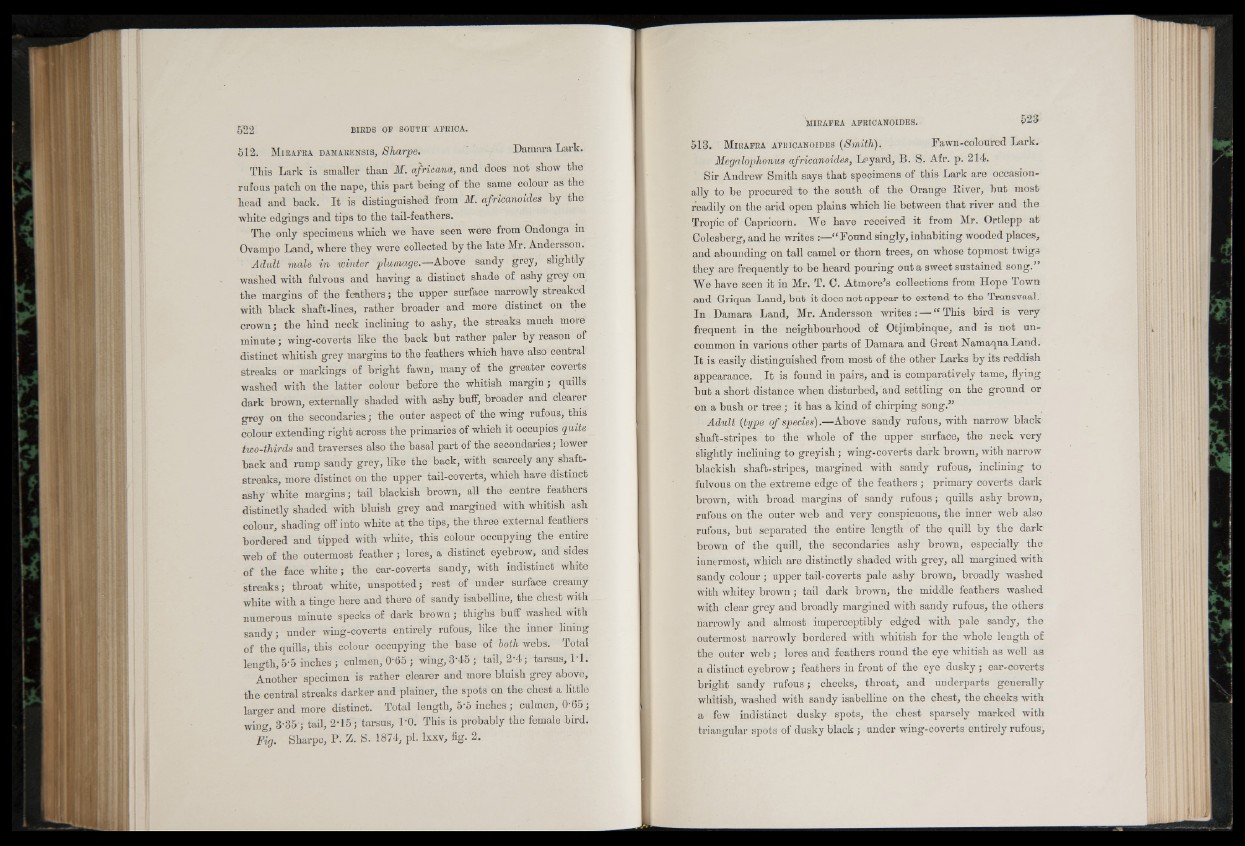
512. M ir a fb a damarensis, Sharpe. Damara Lark.
This Lark is smaller than M. africana, and does not show the
rufous patch on the nape, this part being of the same colour as the
head and back. It is distinguished from M. africanoides by the
white edgings and tips to the tail-feathers.
The only specimens which we have seen were from Ondonga m
Ovampo Land, where they were collected by the late Mr. Andersson.
Adult male in winter plumage.—Above sandy grey, slightly
washed with fulvous and having a distinct shade of ashy grey on
the margins of the feathers ; the upper surface narrowly streaked
with black shaft-lines, rather broader and more distinct on the
crown; the hind neck inclining to ashy, the streaks much more
minute; wing-coverts like the back but rather paler by reason of
distinct whitish grey margins to the feathers which have also central
streaks or markings of bright fawn, many of the greater coverts
washed with the latter colour before the whitish margin ; quills
dark brown, externally shaded with ashy buff, broader and clearer
grey on the secondaries; the outer aspect of the wing rufous; this
colour extending right across the primaries of which it occupies quite
two-thirds and traverses also the basal part of the secondaries; lower
back and rump sandy grey, like the back, with scarcely any shaft-
streaks, more distinct on the upper tail-coverts, which have distinct
ashy white m a r g i n s ; tail blackish brown, all the centre feathers
distinctly shaded with bluish grey and margined with whitish ash
colour, shading off into white at the tips, the three external feathers
bordered and tipped with white, this colour occupying the entire
web of the outermost feather; lores, a distinct eyebrow, and sides
of the face white; the ear-coverts sandy, with indistinct white
streaks; throat white, unspotted; rest of under surface creamy
white with a tinge here and there of sandy isabelline, the chest with
numerous minute specks of dark brown; thighs buff washed with
sandy; under wing-coverts entirely rufous, like the inner lining
of the quills, this colour occupying the base of both webs. Total
l e n g t h , 5-5 inches ; culmen, 0'65 ; wing, 3'45 ; tail, 2'4; tarsus, IT.
Another specimen is rather clearer and more bluish grey above,
the central streaks darker and plainer, the spots on the chest a little
larger and more distinct. Total length, 5‘5 inches ; culmen, 0'65;
wing, 3-35 ; tail, 2T5; tarsus, 1‘0. This is probably the female bird.
Fig. Sharpe, P. Z. S. 1874, pi. lxxv, fig. 2.
513. M ibafra a frica n oid e s (Smith). Fawn-coloured Lark.
Megalophonus africanoides, Lpyard, B. S. Afr. p. 214.
Sir Andrew Smith says that specimens of this Lark are occasionally
to be procured to the south of the Orange River, but most
readily on the arid open plains which lie between that river and the
Tropic of Capricorn. We have received it from Mr. Ortlepp at
Colesberg, and he writes :—“ Found singly, inhabiting wooded places,
and abounding on tall camel or thorn trees, on whose topmost twigs
they are frequently to be heard pouring out a sweet sustained song.
We have seen it in Mr. T. C. Atmore’s collections from Hope Town
and Griqua Land, but it does not appear to extend to the Transvaal.
In.Damara Land, Mr. Andersson writes: — “ This bird is very
frequent in the neighbourhood of Otjimbinque, and is not uncommon
in various other parts of Damara and Great Namaqua Land.
It is easily distinguished from most of the other Larks by its reddish
appearance. It is found in pairs, and is comparatively tame, flying
but a short distance when disturbed, and settling on the ground or
on a bush or tree; it has a kind of chirping song.”
Adult (type of species).—Above sandy rufous, with narrow black
shaft-stripes' to the whole of the upper surface, the neck very
slightly inclining to greyish; wing-coverts dark brown, with narrow
blackish shaft-stripes, margined with sandy rufous, inclining to
fulvous on the extreme edge of the feathers ; primary coverts dark
brown, with broad margins of sandy rufous; quills ashy brown,
rufous on the outer web and very conspicuous, the inner web also
rufous, but separated the entire length of the quill by the dark
brown of the quill, the secondaries ashy brown, especially the
innermost, which are distinctly shaded with grey, all margined with
sandy colour; upper tail-coverts pale ashy brown, broadly washed
with whitey brown; tail dark brown, the middle feathers washed
with clear grey and broadly margined with sandy rufous, the others
narrowly and almost imperceptibly edged with pale sandy, the
outermost narrowly bordered with whitish for the whole length of
the outer web ; lores and feathers round the eye whitish as well as
a distinct eyebrow; feathers in front of the eye dusky; ear-coverts
bright sandy rufous; cheeks, throat, and underparts generally
whitish, washed with sandy isabelline on the chest, the cheeks with
a few indistinct dusky spots, the chest sparsely marked with
triangular spots of dusky black ; under wing-coverts entirely rufous,